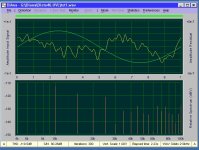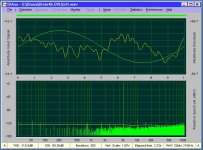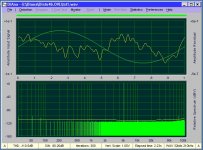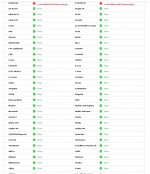Now that all the RTX 6001 have been shipped (and delivered?) it seems to me the right moment to "go public" with a free demo version of DiAna. For those who never heard of DiAna, it's a software tool (in conjunction with a ASIO sound card) to measure distortion (THD+N and THD-N). The pro version also measures IMD and the frequency response. Furthermore, the demo version is a bit crippled in that recording of the signal and data processing has been slow downed (i.e. separated into two steps). As an example, please, see below the loop back results of a Lynx L22 sound card.
As for the lower part of the pictures:
1st. graph: Spectrum of the harmonics only.
2nd graph: Full spectrum with coherent integration (averaging).
3rd graph: Full spectrum with incoherent integration.
As for the upper part all pictures: green is input signal, yellow is residual.
(the height of upper and lower part can be varied at will, of course)
For more details, please send a PM.
Cheers, E.
As for the lower part of the pictures:
1st. graph: Spectrum of the harmonics only.
2nd graph: Full spectrum with coherent integration (averaging).
3rd graph: Full spectrum with incoherent integration.
As for the upper part all pictures: green is input signal, yellow is residual.
(the height of upper and lower part can be varied at will, of course)
For more details, please send a PM.
Cheers, E.
Attachments
How does this determine the residual? Regression from a fit of the input to the output signal (fitting amplitude and time lag)?
Also, will DiAna work on non-Windoze systems (Linux, Macs)?
Also, will DiAna work on non-Windoze systems (Linux, Macs)?
The residual is obtained by subtracting a pure sine from the (coherent integrated) input signal. In order to remove HF rubbish, you can low-pass filter the residual. This is done by means of an FFT and inverse FFT (BTW, actually, I'm using FHT's)How does this determine the residual? Regression from a fit of the input to the output signal (fitting amplitude and time lag)?
Nope, only under 'windoze'. Regarding other systems you might try to run it on an emulator. Probably it works, as DiAna only makes use of standard Win32 calls (no MFC rubbish).Also, will DiAna work on non-Windoze systems (Linux, Macs)?
One more important thing: DiAna is not just a spectrum analyzer, instead, it's a distortion analyzer.
Cheers, E.
Nice software.
Unfortunately, not all RTX have been delivered yet.
When you are ready, give us a download link for the demo version.
Unfortunately, not all RTX have been delivered yet.
When you are ready, give us a download link for the demo version.
DiAna
The file itself can be downloaded at www.data-odyssey.nl/diana/ (not Index of /diana/)
and a few hints to get started can be found at: DiAna
Documentation and help files will come later.
Good luck.
Cheers, E.
The file itself can be downloaded at www.data-odyssey.nl/diana/ (not Index of /diana/)
and a few hints to get started can be found at: DiAna
Documentation and help files will come later.
Good luck.
Cheers, E.
I got this error clicking the download link:This site can’t be reached
www.data-odyssey.nl’s server DNS address could not be found.
DNS_PROBE_FINISHED_NXDOMAIN
www.data-odyssey.nl’s server DNS address could not be found.
DNS_PROBE_FINISHED_NXDOMAIN
That's weird. On my PC it does work. Are you sure no https:// is (automatically) added to the link? How about the other link? Also an error msg?I got this error clicking the download link:This site can’t be reached
www.data-odyssey.nl’s server DNS address could not be found.
DNS_PROBE_FINISHED_NXDOMAIN
I got the same error message with both links, and there is no https:// added.
The domain data-odyssey.nl is resolvable from online DNS portals, so it's probably something to do with my ISP. Given some behavior I've seen, it seems like my ISP is purposely hiding/blocking this site.
The domain data-odyssey.nl is resolvable from online DNS portals, so it's probably something to do with my ISP. Given some behavior I've seen, it seems like my ISP is purposely hiding/blocking this site.
Last edited:
That's weird. On my PC it does work. Are you sure no https:// is (automatically) added to the link? How about the other link? Also an error msg?
Everything works fine for me.
Hilsen
Reodor
Hartley transform
Good question. Since we are dealing here with [FONT=Verdana, Georgia, Arial, Sans-Serif][FONT=Verdana, Georgia, Sans-serif]real-valued data (thus not complex), a[/FONT][/FONT]n FHT is more elegant and slightly faster than an FFT. For further reading, please see: https://www.embedded.com/design/connectivity/4403178/Doing-Hartley-Smartly
Cheers, E.
Hi David,Edmond why did you choose the fast Hartley over Fourier?
Good question. Since we are dealing here with [FONT=Verdana, Georgia, Arial, Sans-Serif][FONT=Verdana, Georgia, Sans-serif]real-valued data (thus not complex), a[/FONT][/FONT]n FHT is more elegant and slightly faster than an FFT. For further reading, please see: https://www.embedded.com/design/connectivity/4403178/Doing-Hartley-Smartly
Cheers, E.
I have the transform code and I'm familiar with this site.
It's also easier to understand. I like that fact that it is the inverse of itself.
It's also easier to understand. I like that fact that it is the inverse of itself.
FHT vs FFT
And, opposed to an FFT, no ugly hassle to store real date in the space for imaginary stuff. That's what I dislike most about an FFT, totally malformed in order to accommodate only real data.
And, opposed to an FFT, no ugly hassle to store real date in the space for imaginary stuff. That's what I dislike most about an FFT, totally malformed in order to accommodate only real data.
Microsoft Security Essentials says the zip contains a virus and automatically deletes the file. This is a first for me. Safe or no?The file itself can be downloaded at www.data-odyssey.nl/diana/ (not Index of /diana/)
and a few hints to get started can be found at: DiAna
Documentation and help files will come later.
Good luck.
Cheers, E.
BK
Edmond try removing the .exe extension and re-zip.
Users can add the extension after DL.
Works for me when emailing exe's.
Users can add the extension after DL.
Works for me when emailing exe's.
Have you played around with the Hilbert transform.
It's quite cool. One can generate the cosine of a signal. Make the other half for FFT.
It's quite cool. One can generate the cosine of a signal. Make the other half for FFT.
The residual is obtained by subtracting a pure sine from the (coherent integrated) input signal.
But how do you determine the amplitude and the time / phase shift of the signal used to subtract?
Indeed, a good question. To do it right and accurately, it is far from easy. As for the fundamental, hundreds lines of code were needed to extract the frequency, phase, amplitude and offset from the data. How exactly I've done it, I won't tell you, sorry. But it is done as accurate as possible with an error rate in the order of 1E-6 to 1E-22, depending on the background noise, of course (as you know: 'garbage in, garbage out', which also applies in this case, alas).
It is a false positive as only two out of 60 virus scanners are wining about "not-a-virus:AdWare.Win32.Gamevance.gen", see list below (generated by virustotal.com). Anyhow, a virus or not, it's harmless.Microsoft Security Essentials says the zip contains a virus and automatically deletes the file. This is a first for me. Safe or no?
BK
Cheers, E.
Attachments
- Home
- Design & Build
- Equipment & Tools
- DiAna, a software Distortion Analyzer



